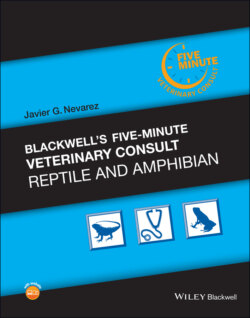Читать книгу Blackwell's Five-Minute Veterinary Consult: Reptile and Amphibian - Javier G. Nevarez - Страница 203
Оглавление
Hypovitaminosis A
BASICS
DEFINITION/OVERVIEW
Hypovitaminosis A is a well‐recognized health concern in pet carnivorous, insectivorous, and omnivorous chelonians. The primary cause is feeding food items deficient in the correct form of vitamin A for the species or in under/incorrectly supplementing vitamin A.
ETIOLOGY/PATHOPHYSIOLOGY
In vertebrates, vitamin A forms are trans‐ retinyl esters, trans‐retinol, ‐retinal and ‐retinoic acid (99% of all vitamin A present in body), while the major dietary provitamin A carotenoid is beta carotene.
The all‐trans‐vitamin A isomers are the only forms used physiologically.
Carnivores, insectivores, and possibly omnivores need these forms in their diet.
While reptile herbivores can convert carotenoids lutein and canthaxanthin into trans‐retinyl esters, beta carotene does not convert as well.
Hypovitaminosis A in herbivores is extremely unlikely, excepting after long periods of anorexia.
The liver absorbs and stores preformed vitamin A. Other storage sites include adipose, lung, and kidney.
In humans, retinoid delivery pathway to tissues involves primarily retinol bound to retinol‐binding protein; chylomicrons, very low density lipoprotein, low density lipoprotein, and albumin also provide transport.
Adverse effects in humans include night blindness, impaired immune function, cancer, and birth defects.
SIGNALMENT/HISTORY
First‐time owner of reptiles/species.
Supplementing with beta carotene‐based vitamin A or no supplementation.
Box turtles (Terrapene carolina sp.) and sliders (Trachemys scripta sp.) may present more commonly.
CLINICAL PRESENTATION
Most present with non‐specific signs such as anorexia, dehydration, and lethargy.
Upper respiratory signs include bilateral nasal–ocular discharge, blepharedema, conjunctivitis, “pus” in conjunctival sacs (actually desquamated debris), swelling and closure of palpebral fissures due to squamous metaplasia and glandular hypertrophy, and secondary bacterial infections.
Ulcerative stomatitis, glossal plaques, and glossitis may also be observed.
Chelonian aural abscesses do not appear to be directly associated with hypovitaminosis A based on current findings, but squamous
metaplasia may lead to secondary aural infections.
RISK FACTORS
Husbandry
Insectivore, carnivore not receiving vertebrate prey with liver.
Others
N/A
DIAGNOSTICS
DIFFERENTIAL DIAGNOSIS
Bacterial infection
Hepatic/renal disease
UVB/thermal burns
Ocular trauma
Water‐based toxins
Poor overall husbandry/diet
Improper conspecific arrangement
Metabolic bone disease
DIAGNOSTICS
Presumptive diagnosis is based upon history, clinical presentation, and response to correct supplementation.
Liver biopsy for histopathology and testing vitamin A levels can be performed, but there is a lack of normal values.
Hepatic vitamin A levels are normally extremely high in carnivores, much lower in herbivores, and intermediate in insectivores and omnivores.
Sex of animal, testing methodology, and reported units can affect results.
PATHOLOGICAL FINDINGS
Squamous metaplasia
Epidermal ulceration
TREATMENT
APPROPRIATE HEALTH CARE
N/A
NUTRITIONAL SUPPORT
Omnivores and carnivores can be fed whole prey still containing liver, or for semiaquatic turtles, can offer extruded diet with correct form of vitamin A.
Supportive feeding, including esophageal feeding tubes may be needed until the reptile feels better and can actually see the food.
For herbivores, feed plenty of leafy greens and red/orange/yellow vegetables.
Treatment for insectivores is more complex.
Invertebrates store retinols in the retina only, so invertebrates (or juvenile forms) without eyes have no vitamin A.
Dusting invertebrates must be done immediately before feeding, as the vitamin powder is usually often self‐groomed off the invertebrate before the reptile has ingested it.
Gut‐loading guidelines are still controversial but seem to still be the best option—especially consider the Li diet (see Suggested Reading).
Consider feeding non‐toxic, wild‐caught invertebrates, as they generally have much higher levels of vitamin A than captive‐raised invertebrates.
CLIENT EDUCATION/HUSBANDRY RECOMMENDATIONS
Proper education about correct diet for the species.
Discuss correct formulation of vitamin A for the species.
Correct invertebrates to offer and how to supplement them.
Clear explanation of differences between water‐soluble and fat‐soluble vitamins.
MEDICATIONS
DRUG(S) OF CHOICE
Parenteral treatment or oral supplementation of retinol forms to herbivores should be avoided.
Use dietary carotenoids (non‐beta carotene) instead.
For omnivorous, carnivorous, and insectivorous reptiles, parenteral vitamin A (usually has vitamin D3 as well): 500–5,000 iu/kg IM q7–14d for up to 4 treatments.
Dosing must be done carefully to avoid over supplementation with vitamin A in the retinol form.
Other treatment focuses on managing with systemic antibiotics/antifungals for secondary infections.
Judicious topical use of silver sulfadiazine cream for epidermal ulcers can help.
Removal of conjunctiva plugs or flushing nasolacrimal ducts (when present) can be beneficial symptomatic treatment.
PRECAUTIONS/INTERACTIONS
Vitamin A interacts with other fat‐soluble vitamins (D, E, K).
FOLLOW‐UP
PATIENT MONITORING
Re‐evaluate for improvement of clinical signs.
Review owner’s diet plan
Repeat liver biopsy if feasible
EXPECTED COURSE AND PROGNOSIS
Usually chronic, clinical resolution can take several months with most manifestations resolving, though renal damage may be permanent.
MISCELLANEOUS
COMMENTS
N/A
ZOONOTIC POTENTIAL
N/A
SYNONYMS
N/A
ABBREVIATIONS
IM = intramuscular
UVB = ultraviolet B
Suggested Reading
1 Chen LP, Huang CH. Estimation of dietary vitamin A requirement of juvenile soft‐ shelled turtle, Pelodiscus sinensis. Aquacult Nutr 2015;21:457–463.
2 Li H, Vaughan MJ, Browne RK. A complex enrichment diet improves growth and health in the endangered Wyoming toad (Bufo baxteri). Zoo Biol 2009;28:197–213.
3 Mans C, Braun J. Update on common nutritional disorders of captive reptiles. Vet Clin North Am Exot Anim Pract 2014;17(3):369–395.
4 Miller EA, Green SL, Otto GM, Bouley DM. Suspected hypovitaminosis A in a colony of captive green anoles (Anolis carolinensis). Contemp Top Lab Anim Sci 2001;40:18–20.
Author Eric Klaphake, DVM, DACZM
